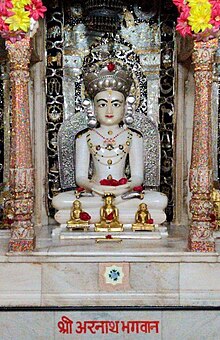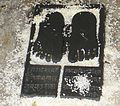|
Aranatha
Aranatha, also known as Arnath was the eighteenth Jain Tirthankar of the present half cycle of time (Avasarpini).[2] He was also the eighth Chakravartin[3] and thirteenth Kamadeva. According to Jain beliefs, he was born around 16,585,000 BCE. He became a siddha i.e. a liberated soul which has destroyed all of its karmas. Aranath was born to King Sudarshana and Queen Devi (Mitra) at Hastinapur in the Ikshvaku dynasty.[2] His birth date was the tenth day of the Migsar Krishna month of the Indian calendar. LifeLike all other Chakravartin, he also conquered all the lands[3] and went to write his name on the foothills of mountains. Seeing the names of other Chakravartin already there, he saw his ambitions dwarfed. He then renounced his throne and became an ascetic for penance.[3] At an age over 84,000 years he and attained Moksha (liberation) on Mount Shikharji.[3] WorshipSvayambhūstotra by Acarya Samantabhadra is the adoration of twenty-four tirthankaras. Twenty slokas (aphorisms) of Svayambhūstotra are dedicated to Tirthankar Aranath.[4] One such sloka is:
As a historical figureAt Mathura, there is an old stupa with the inscription of 157 CE. This inscription records that an image of the tīrthankara Aranath was set up at the stupa built by the gods. However, Somadeva Suri stated in Yashstilaka and Jinaprabha Suri in Vividha Tirtha Kalpa that the stupa was erected for Suparśvanātha.[6] Temples
See alsoWikimedia Commons has media related to Aranatha. References
Sources
|
|||||||||||||||||||||||||||||||||||||||||||||





